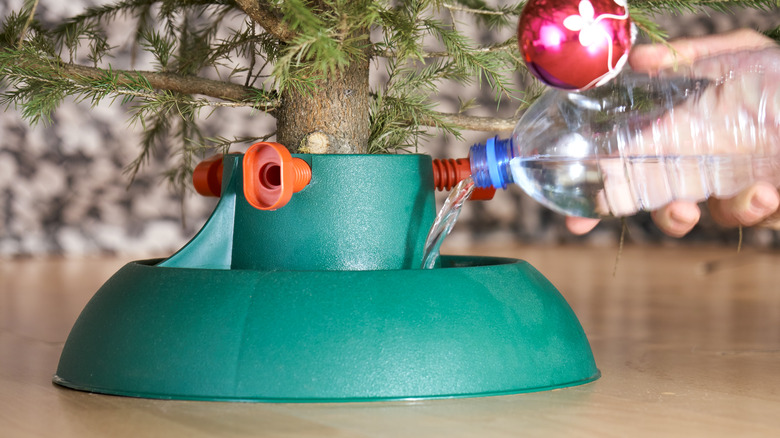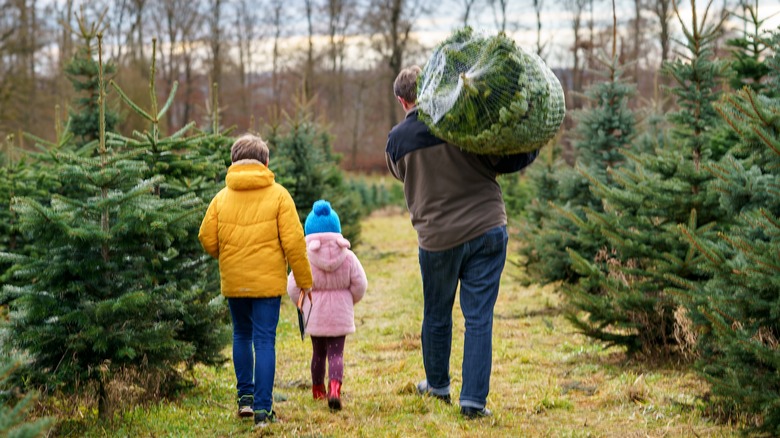Garden Trees, Shrubs & Vines
Nancy Chandler
After spending a day at a Christmas tree farm, bundled up against the cold with a warm scarf and a cup of hot chocolate, you and your loved ones have found the perfect Christmas tree. It’s time to make your purchase and bring the magic of the Christmas season into your home. There’s nothing better than the smell of a live evergreen in the house, especially one that’s been decorated with twinkling lights and sparkling ornaments. But how can you preserve the life of your Christmas tree for as long as possible?
When it comes to the question of how to keep a Christmas tree healthy, there are all kinds of suggestions to consider, some more reasonable than others. One theory is to add vodka to the tree’s water basin. Jennifer Hart of Westwood Gardens, a nursery and garden center in Fayetteville, Arkansas doesn’t recommend this solution. “If you have any indoor pets, a lot of times they will drink from the water and that could cause a few holiday issues,” Hart explains to 5News.
Other suggestions include dropping a penny in the water, adding bleach, or even birth control pills to the tree’s water supply, according to Laidback Gardener. While some of these suggestions may seem outrageous, there’s one piece of advice that appears to have some merit. Would adding sugar to the water help your tree last longer? Let’s see what some experts have to say.
Plain water is best

Georgy Dzyura/Shutterstock
Sugar water does not help extend your tree’s life, according to R.J. Laverne, an ISA Board Certified Master Arborist (via Davey). “I’m not aware of any substantial benefits of adding anything to the water,” Laverne explains. He emphasizes that the tree will benefit the most simply by having enough water. “If you keep the basin of the Christmas tree stand filled on a regular basis, you won’t have to worry about placing any additives in the water,” he says. Coe Roberts, a certified arborist who works with the Arbor Day Foundation, agrees with this advice. “Water. Water. Water.” He emphasizes this simple point by saying, “Trees bought in early December that don’t receive adequate water will likely be unacceptably dry by the time the 25th rolls around.”
Anything artificial added to a tree’s water source could actually harm the tree’s ability to absorb water, and doing so could even cause the tree to lose its needles more quickly, states the National Christmas Tree Association. According to expert arborists, the key to preserving a tree isn’t found in a magic additive like adding sugar to the water. It is, however, important to maximize the ways that the tree can absorb as much water as possible. There are some simple steps to follow to make sure this happens, and they begin as soon as you select your tree.
Keeping the tree healthy

Irina Wilhauk/Shutterstock
Tchukki Andersen, a board-certified master arborist at the Tree Care Industry Association, explains “Your tree preservation efforts need to start at the Christmas tree lot or farm,” (per Davey). “Give the tree a shake before you buy. If lots of needles fall off, you’ll be doomed.” Another piece of advice is to choose a fir tree, which doesn’t lose its needles as quickly as other types of evergreen trees. Before heading home, protect the tree with plastic or a net covering.
Once you’ve arrived home and made a fresh cut at the tree’s base, how much water will the tree need? Experts from the departments of Horticulture and Forestry suggest how to estimate this amount by first measuring the cut end of the tree, via Michigan State University. For every inch of diameter, the tree will need about a quart of water per day. For example, a tree that is seven feet tall might have a trunk that is about three inches wide. A tree this size would need about three quarts of water per day. It’s actually a good indicator that the tree is being refreshed when it continues to absorb water. However, the study emphasizes that regular tap water, not sugar water, is what’s best to keep the tree healthy.

